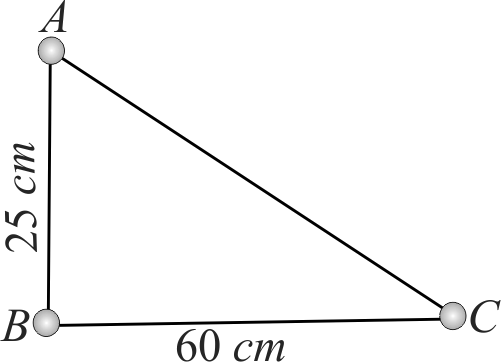359457
\({A B C}\) is a right-angled triangle, where \({A B}\) and \({B C}\) are 25 \(cm\) and 60 \(cm\) respectively. A metal sphere of 2 \(cm\) radius charged to a potential of \({9 \times 10^{5}}\) volt is placed at \({B}\). Find the amount of work done in carrying a positive charge of 1 Coulomb from \({C}\) to \({A}\).
359458 A particle of mass \(400\,mg\) and charged with \({5 \times 10^{-9} {C}}\) is moving directly towards a fixed positive point charge of magnitude \({10^{-8} {C}}\). When it is at a distance of \(10\,cm\) from the fixed positive point charge it has a velocity of \({50 {~cm} / {s}}\). At what distance from the fixed point charge will the particle come momentarily to rest?
359457
\({A B C}\) is a right-angled triangle, where \({A B}\) and \({B C}\) are 25 \(cm\) and 60 \(cm\) respectively. A metal sphere of 2 \(cm\) radius charged to a potential of \({9 \times 10^{5}}\) volt is placed at \({B}\). Find the amount of work done in carrying a positive charge of 1 Coulomb from \({C}\) to \({A}\).
359458 A particle of mass \(400\,mg\) and charged with \({5 \times 10^{-9} {C}}\) is moving directly towards a fixed positive point charge of magnitude \({10^{-8} {C}}\). When it is at a distance of \(10\,cm\) from the fixed positive point charge it has a velocity of \({50 {~cm} / {s}}\). At what distance from the fixed point charge will the particle come momentarily to rest?
359457
\({A B C}\) is a right-angled triangle, where \({A B}\) and \({B C}\) are 25 \(cm\) and 60 \(cm\) respectively. A metal sphere of 2 \(cm\) radius charged to a potential of \({9 \times 10^{5}}\) volt is placed at \({B}\). Find the amount of work done in carrying a positive charge of 1 Coulomb from \({C}\) to \({A}\).
359458 A particle of mass \(400\,mg\) and charged with \({5 \times 10^{-9} {C}}\) is moving directly towards a fixed positive point charge of magnitude \({10^{-8} {C}}\). When it is at a distance of \(10\,cm\) from the fixed positive point charge it has a velocity of \({50 {~cm} / {s}}\). At what distance from the fixed point charge will the particle come momentarily to rest?
359457
\({A B C}\) is a right-angled triangle, where \({A B}\) and \({B C}\) are 25 \(cm\) and 60 \(cm\) respectively. A metal sphere of 2 \(cm\) radius charged to a potential of \({9 \times 10^{5}}\) volt is placed at \({B}\). Find the amount of work done in carrying a positive charge of 1 Coulomb from \({C}\) to \({A}\).
359458 A particle of mass \(400\,mg\) and charged with \({5 \times 10^{-9} {C}}\) is moving directly towards a fixed positive point charge of magnitude \({10^{-8} {C}}\). When it is at a distance of \(10\,cm\) from the fixed positive point charge it has a velocity of \({50 {~cm} / {s}}\). At what distance from the fixed point charge will the particle come momentarily to rest?